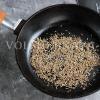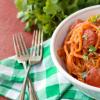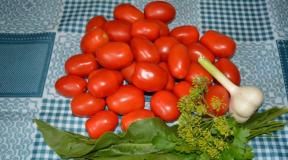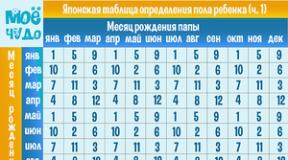Separate meals and children. Separate food system for children - Separate baby food
Daria and Galina Dmitrievs
Separate food
INTRODUCTION
There are no medical dogmas in this book that must be strictly followed. The authors tried to outline the essence of a separate nutrition system, the main task of which is the ability to correctly combine food products.
If you are not an enemy of your health, this book is for you. She will teach you how to correctly use and combine products necessary for your body. 101 products recommended by the authors contain the “right composition” - the composition that will help you live a long and productive life and get rid of diseases.
1. MAIN ABOUT THE SEPARATE POWER SYSTEM
The main task of practicing separate meals is to learn how to combine foods correctly. But before you start mastering the separate power supply system, you need to learn how to right choice food products. Nutritious food has much in common with a separate nutrition system. They are united by a limitation in the consumption of industrially processed products, since during such processing vitamins, microelements, minerals and enzymes.
In addition, when processed industrially, products are often mixed with nutritional supplements, which can also be harmful to health.
In a separate nutrition system, when choosing food, preference is given to plant products. This is due to the fact that toxic substances accumulate in high concentrations in the animal’s body, which enter it in different ways, for example, through plant food obtained from plants treated with artificial fertilizers and pesticides, as well as residues of medications (including hormones). It should also be taken into account that the animal’s body contains hormones that are formed due to the animal’s mortal fear of slaughter.
All of the above-mentioned toxic substances consumed by a person along with meat can adversely affect his health. In addition, you should avoid eating offal, wild mushrooms, as well as foods that contain all kinds of food additives - all of them are replete with toxic substances. When choosing food products, preference should be given to environmentally friendly plant products grown without the use of artificial fertilizers and pesticides, grown specifically in a given area and in accordance with the season, which reduces their transportation routes and storage period.
The separate nutrition system therefore recommends, whenever possible, eating only natural and industrially unprocessed foods. It is necessary to avoid overly processed foods, such as white sugar, factory fats, white flour and foods prepared from it. On the contrary, the consumption of greens is highly recommended, because in their natural form, plants contain all the elements necessary for the human body in a highly concentrated form. These substances include vitamins, amino acids, minerals, trace elements and enzymes.
The separate feeding method consists of two basic rules:
– consume proteins and carbohydrates separately;
– constantly maintain acid-base balance in the body.
If we properly combine the food we consume, then we ensure more efficient absorption of it, since we do not benefit from food that is difficult to digest. Therefore, the right combination of food, in addition to better absorption, protects our body from poisons. Some people suffer from food allergies, for example; Having learned to combine foods correctly, they easily part with it. Allergy is a form of protein poisoning. The food products we purchase are only raw materials for nutrition, which, by the way, in addition to useful organic compounds, also contain indigestible substances, simply put, waste.
The food we consume is broken down into the smallest elements in the digestive tract with the help of digestive juices and enzymes. After this, they travel from the intestines to the liver. There, the body either collects elements according to its own pattern, or completely digests them to obtain energy. Products in their pure form are not absorbed by the body. At the beginning they undergo decay.
Digestive physiology refers to the complex chemical changes that occur in the digestive tract. Changes in the digestive process are greatly influenced by enzymes - non-living enzymes. All foods produce enzymes during the digestion process. Enzymes act as a physiological catalyst in the stomach. And from chemistry we know that many substances do not interact with each other, but can combine in the presence of a third substance. It only facilitates the onset of the reaction. Such a substance, or agent, is called a catalyst, and the process itself is called catalysis. Previously, these substances were called enzymes, since their action in the digestive process resembles fermentation, which is carried out by living enzymes - bacteria. The products obtained during the fermentation process, which are not identical to the enzymes formed in the stomach, are poisonous. Rotting also causes the formation of poisons. Each enzyme affects only one class of food products: carbohydrates, proteins, salts, fats... And they only do their job. If, for example, pepsin has not converted proteins into peptones, then the enzymes that convert peptones into amino acids cannot act on the above-mentioned proteins, etc.
The process of digestion begins with breaking up food in the mouth. Already in the saliva an enzyme (ptialin) appears, which breaks down starch into maltose (a complex sugar). Maltose, entering the intestines and acting as a new enzyme, converts it into simple sugar. Starch that has not been digested in the mouth and stomach can be broken down if it has undergone fermentation on its way to the stomach. The enzyme found in the mouth is called ptyalin. If we mix starches of different compositions, then the effect of ptyalin stops, and we get an acidic reaction in the body, which will be discussed below. Depending on the nature of the food eaten, the composition of the gastric juice changes: from neutral to highly acidic.
Gastric juice contains three enzymes - pepsin, lapase and irennene. Only pepsin is able to initiate the digestion of all types of proteins. Protein is broken down by different enzymes at different stages of digestion. Without the previous action of pepsin, other enzymes are unable to break it down. Pepsin acts only in an acidic environment, which can be neutralized by alkali. When drinking chilled drinks, the effect of pepsin slows down or stops altogether; the result is stomach pain. The stomach sometimes hurts after eating a portion of ice cream, which contains sugar, protein and fats, and as is already known, pepsin cannot simultaneously break down various substances that enter the stomach during the digestion process. Alcohol also precipitates this enzyme.
Mothers who prefer separate meals often wonder whether the same system can be used to feed not only themselves, but also their child.
We eat separately - what is the essence of the system?
The ideological inspirer, author and practitioner of this dietary option was Herbert Shelton, a scientist from the United States. His system is based on the fact that carbohydrates and proteins that enter the gastrointestinal tract with food require different enzymes and different amounts of gastric juice for processing. Differences in the chemical composition make it necessary to eat such products separately. To break down carbohydrates (potatoes, pasta, cereal, bread and sugar) an alkaline environment is needed, while proteins (fish, cheese, meat, nuts, eggs) require an acidic environment. If you mix both proteins and carbohydrates at one meal, then most of the food will not be processed and will remain to rot in the stomach.
According to Shelton, there are also neutral products - these are vegetable oils, greens, fruits, vegetables, butter, cottage cheese, as well as the cottage cheese itself. They can be eaten in combination with both carbohydrates and proteins.
Separate meals: key rules
- Don't mix carbohydrates and proteins. Do not eat cheese, eggs, nuts, meat and fish dishes with fruits, potatoes, and baked goods.
- Don't eat acidic and carbohydrate foods at the same time. Do not put tomatoes, citrus fruits, apples with legumes, cereals, potatoes, bread and bananas on the same plate.
- Avoid eating proteins and acidic fruits and vegetables at the same meal. Do not add pineapples, oranges, other citrus fruits, or tomatoes to eggs, meat, nuts or cheese.
- Do not mix proteins with fats. Do not combine vegetable or butter with nuts, egg or meat dishes.
- From different types of protein products, always choose one. There is no need to combine cheese with meat or eggs with nuts in one dish.
- Do not combine starch and sugar on the same plate. If you eat syrup, honey, jam or jam along with porridge, buns or potatoes in one meal, the fermentation process will start in the intestines.
- Always choose only one type of starch for each meal. Give preference to one thing - cake or beans, bread or potatoes.
- Remember that melon and milk cannot be combined with anything else.
According to Russian nutritionists, the idea of separating products is sound, this way the necessary acid-base balance is maintained in the gastrointestinal tract. But for children under 6-7 years old it is better to use individual elements of this system.
According to Russian nutritionists, the idea of separating products is sound, since it allows you to maintain the balance of alkali and acid in the gastrointestinal tract. But separate meals for children under six or seven years of age, it is better to use it in the form of an adapted version of the system, using only its individual elements.
This is especially true for Shelton’s recommendations related to a raw food diet. According to domestic doctors, since a child’s fermentation systems are immature, an excessive amount of food served raw can lead to disruption of the gastrointestinal tract.
Again, following the separate nutrition system, remember that there are no purely protein or purely carbohydrate products; after all, each of them contains both, vitamins, and microelements, that is, the division is quite arbitrary.
On the other hand, the children themselves sometimes tell us how to separate products. They stubbornly refuse to eat sausage with bread, eating only sausage. They themselves say that they don’t want to eat bread with soup. Try to combine your knowledge about separate meals with your child's individual habits. Perhaps he himself intuitively feels what he needs.
What about kindergarten?
Naturally, you will have a problem with choosing kindergartens, because their food standards imply a cutlet with potatoes. Now this issue has begun to be resolved; kindergartens for children whose parents insist on separate meals, preferably without meat, have opened and continue to open in Moscow, St. Petersburg, Nizhnekamsk, Yekaterinburg, Voronezh. The average cost of children staying there in 2013 was 1,100 rubles per day. As a rule, these are home kindergartens - a mother passionate about raw food or vegetarianism gathers 10-15 children in her apartment and prepares them porridge from soaked green buckwheat, herbal infusions and a variety of salads. Instead of the usual sweets - flatbreads made from sprouted wheat and dogwood. Instead of packaged juices - cocktails from cilantro, dill and banana with almond milk. Of course, there are not many such gardens, but there is always the opportunity to throw a call on VKontakte and find like-minded people.

A few more tips about proper organization nutrition
The separate nutrition system is interesting because it takes into account not only what you eat, but also how you do it.
- Eat only when you feel hungry.
- Refuse food if you are too tired or feel unwell (the temperature has risen, any inflammatory processes have made themselves felt).
- Always sit down at the table in a good mood.
- Remember that nutrition is an independent process, so do not turn on the TV or read books during lunch.
- Do not drink pure water while eating. It is better to drink fruit drink, juice, green tea or fruit compote 15 minutes before meals.
- Eat slowly, do not rush or rush children.
- Try to offer your child only natural food. Reduce processing time whenever possible, avoid sterilized products, products enriched with preservatives, flavor enhancers and other chemical additives.
- Don't overfeed your baby. Let him have only 3 fairly moderate meals a day.
- Give your baby simple food - one that will not cause fermentation in the stomach.
- Make sure your child chews each piece very thoroughly.
- Avoid snacking at night and between meals.
- Listen to your child. Often children prefer to eat only one product at one meal - so be it.
- Remember that sandwiches are the work of man, not nature.
- Do not use preserves and jams, because they have nothing in common with natural fruits.
- There should be no cookies on your table, quick breakfasts, tea, chocolate and cocoa.
Many of these tips are also suitable for those who do not actively share Shelton's position on food. In any case, parents need to think about what they are introducing into the child’s body with food.
Many people have heard about the idea of product compatibility, but few have put it into practice. It seems difficult, requiring willpower, which is sorely lacking. In fact, such a system does not require large moral costs, because it does not involve a hunger strike or any restrictions, but compliance with certain rules. The theory of separate nutrition for the purpose of losing weight, popular in the early 19th century, still finds its supporters. There are also many opponents who expose the idea itself and its founder.
- What is separate nutrition? Basic principles
- Groups of foods that require the production of different enzymes
- Unacceptable combinations for separate meals
- Product compatibility table for separate meals
- How to use the table
- Sample menu for 1 day (taking into account the table data)
Advantages of separate nutrition Arguments of supporters and opponents of separate nutrition 
The separate nutrition system is based on the theory of Herbert Shelton, which he outlined in the book “The Correct Combination of Foods.” The book was published in 1928 and immediately gained popularity among Hollywood stars, mainly his patients.
Separate nutrition is based on the idea of food compatibility, the same for all people. Shelton believed that the enzymes produced by the stomach to digest different types of food differ. Thus, the enzymes needed to break down carbohydrates will not be able to process proteins and vice versa. If you eat one type of food at one time, this will greatly facilitate the process of digestion and assimilation.
If preference is given to traditional food, in which different ingredients are mixed, then the stomach begins to secrete several enzymes at once. As a result, some foods are broken down faster, others slower, which leads to their long stay in the stomach. This, in turn, entails processes of fermentation, rotting, causes intoxication of the body, and metabolic processes are disrupted. Consequently - overweight, slagging, poor health.
According to Shelton and his followers, individual food groups should not be combined with each other; they should be consumed only after the previous food has been digested and absorbed. Following the separate nutrition system, it is necessary to give up tea and coffee, store-bought juices, and products containing preservatives, since the ingredients have already been mixed here.

Groups of foods that require the production of different enzymes
Separate meals for weight loss have the main rule: never consume proteins and carbohydrates at the same time. In order for proteins to be absorbed, an acidic environment is required; to break down carbohydrates, an alkaline environment is required. If you eat proteins together with carbohydrates, alkaline and acidic enzymes will be simultaneously released for absorption, neutralizing each other. As a result, the digestion process will be noticeably slowed down; not all food will be processed in the stomach.
Products requiring an acidic environment (protein foods):
- all types of meat;
- eggs of any bird;
- Fish and seafood;
- milk and products made from it (including cheeses);
- mushrooms and nuts.
Starch is considered one of the most common carbohydrates. Starchy vegetables include potatoes, green pea, pumpkin, zucchini, cabbage, carrots, beets. Little starch is found in green vegetables: cucumbers, celery and others. Carbohydrates in the form of sugar are found in honey, sweet fruits and dried fruits. This group of products will require an alkaline environment. In addition, it is necessary for processing cereals and flour products, bananas, chocolate and candies, and other sweets. Beer is also a carbohydrate, so combining it with fish and meat is unacceptable.
Fats are vegetable oils, fatty meats and fish, nuts and seeds. Semi-acid fruits - sweet apples, pears, apricots and peaches, plums, many berries.

Unacceptable combinations for separate meals
Based on data on the composition of foods that require different enzymes to digest, Shelton came up with combinations that should not be used together:
- Protein + protein (especially saturated protein). You cannot combine, for example, meat and fish, or add eggs or nuts to them. All of these contain proteins that are qualitatively different from each other. To digest such dishes, a considerable amount of gastric juice is needed; they will be processed and pass through the digestive tract for a very long time. This causes discomfort: gas formation, bloating, intestinal disturbances.
- Proteins + fats (including vegetable ones). Fat coats the stomach, preventing sufficient gastric juice from being produced to process and digest protein. As a result, food takes longer to digest, and some of it remains unprocessed.
- Proteins + acids. Sour fruits should not be eaten with protein foods: meat, eggs, cottage cheese. The acid released by the stomach is enough to break them down. Fruits only slow down the process, causing increased acidity and heartburn. You cannot eat sour fruits immediately after protein: protein is digested mainly in the stomach, so it stays there for 4-6 hours, while the absorption of fruits and berries occurs in the intestines, they are in the stomach for only half an hour. Being here longer, they begin to wander, everything beneficial features break apart.
- Carbohydrates + acids. Digestion of carbohydrates requires an alkaline environment, while excess acidity destroys the enzyme ptyalin, which is necessary for the breakdown of carbohydrates.
- Carbohydrates + carbohydrates. Foods rich in carbohydrates inhibit the digestion process and slow down metabolism. Excess carbohydrates accumulate in the body as fat. That's why it's not worth it mashed potatoes eat bread.
- Carbohydrates + sugar. Sweet foods don't go well with anything at all. If you really want to treat yourself to a piece of cake or your favorite candy, it’s better to do it separately from the rest, as an independent meal, and not as an addition to it in the form of dessert. It’s better to eat sweets before lunch so that it doesn’t affect your weight loss.
- Milk should not be consumed with anything other than independent drink meal replacement. In general, Sheldon believed that a person could live without milk. This is a baby product. Each animal has a special composition of milk (cow, goat, and human breast milk are completely different in properties). It is practically not processed by the body, so there is little benefit from it.
- Melon is very healthy, contains many vitamins and minerals, and cleanses the body. But you need to eat it strictly separately. If you eat it with any other food, it will not be beneficial.
Product compatibility table for separate meals

How to use the table
The table below the numbers shows the main product groups (vertically and horizontally). To understand whether it is possible to combine certain ingredients when cooking, just find them, find out the numbers and look at the color that appears when they intersect. For example, fish and meat (1) go well with non-starchy vegetables (11); their combination with starchy vegetables (12) is acceptable. But the remaining cells are colored red - these are those products that cannot be consumed together with meat.
Sample menu for 1 day (taking into account the table data)
Guided by the principles of combination, it is not difficult to create a menu for separate meals.
Breakfast
Scrambled eggs with herbs (white version)
Porridge cooked in water (carbohydrate version)
Dinner
Boiled chicken breast or steamed fish (protein option)
Baked (boiled) potatoes or pasta (carbohydrate option)
Dinner
Cottage cheese or kefir (yogurt without additives)
Salad from fresh vegetables or fruit (carbohydrate option)
Important to know: Carbohydrate foods should alternate with protein foods containing fats or acidic foods. So, if you ate protein food for breakfast, then carbohydrate food for lunch, and dinner should consist of fruits.
Video: Separate nutrition: the essence of the diet and menu
Advantages of separate power supply
Many diets are based on the refusal of certain foods and restrictions, which often causes disruptions in the functioning of the body, which does not receive the necessary substances in full. For the same reason, it is difficult for dieters to cope with excess weight, since after stress the body stores substances for future use in case of another shortage. Separate consumption is not a diet in the generally accepted sense, it is rather a system proper nutrition that you can stick to all the time. In addition to losing weight, adherents of the system consider the following advantages of separate nutrition:
- Normalization of metabolism. Improper functioning of the digestive organs often causes excess body weight. The establishment of metabolic processes leads to the fact that food does not stay in the body longer than usual, all unnecessary substances leave it in a timely manner, without being deposited as fat.
- Setting up work of cardio-vascular system. Since, with separate nutrition, the processes of putrefaction and fermentation in the body completely stop, the decay products, the main cause of atherosclerotic vascular lesions, do not enter the blood. With this approach, almost all cholesterol is removed, and new cholesterol no longer accumulates.
- Varied menu. Almost everything can be used. The main thing is to stick to compatibility. When following the principles of separate nutrition, there is no feeling of hunger, since the goal is not to limit, but to improve digestion and absorption of food. It is noted, however, that the portion should not exceed 300-400 g at a time.
Separate nutrition does not involve eating food at regular intervals. It is important to wait until you feel a slight feeling of hunger, then start eating. For some people, twice is enough. If the next day you want to eat three times, you don’t need to suppress your hunger. Sooner or later, the body will choose its own regime.
Video: Nutritionist Kovalkov: myths about separate meals. What actually goes together
Arguments of supporters and opponents of separate nutrition
Proponents of separate nutrition base their assumptions not on any research, but on the belief that initially humans, like other mammals, consumed foods unchanged (that is, only meat or only vegetables). Over time, people learned to mix different ingredients to improve the taste.
Opponents argue that a separate nutrition system is impossible in principle, because there are practically no products containing only protein or only carbohydrates (except perhaps sugar and egg whites). They also debunk the basic idea of “food rotting in the stomach,” which, according to Shelton, causes health problems and excess weight.
Doctors (S. Baxter, E. Chedia, L. Vasilevskaya and others) proved that, in addition to gastric enzymes, pancreatic enzymes are involved in processing. In addition, R. Minvaleev, a physiologist and candidate of biological sciences, notes that only preliminary processing of food occurs in the stomach; it is completely broken down and absorbed in the duodenum. All possible enzymes are produced here, regardless of what type follows the digestive tract (only protein, only carbohydrate, acidic or mixed).
Much that a person consumes together actually requires the production of various enzymes, but they do not interfere with each other, but complement and help break down indigestible substances. This leads to the fact that food is quickly processed, and its remains leave the body without causing harm to it. Opponents of the separate power supply system give the following arguments:
- Meat protein will be absorbed worse if it is not consumed together with carbohydrates (bread or vegetables), which activate the production of pancreatic enzymes necessary for processing protein in the intestines.
- Acidic fruits help absorb iron, so they are often eaten with grains.
- Fiber, which is abundant in any vegetables, is important for proper operation and timely cleansing of the intestines. Vegetables have always been considered an excellent complement to meat, because the fiber they contain is necessary for proper functioning and cleansing of the intestines.

However, separate meals for weight loss are suitable by reducing the calorie content of food and streamlining its intake. Much of what Shelton proposed forms the basis healthy eating. For example, everyone knows that it is better not to fry meat (proteins + fats), but to boil, stew or steam it. But it’s really better to eat fruits separately; they are absorbed together with fats.
Separate food
Separate nutrition takes into account compatibility various products between each other and allows you to avoid disturbances in the digestive process and the occurrence of many diseases in the future. It’s great if you start practicing separate meals as a family.
What does this mean, separate nutrition?
Protein foods should be eaten separately from carbohydrate foods. Why? Because the processes of their assimilation in the body differ too much: both in time and in the nature of the digestive tract juices required for this. If food is eaten separately, digestion occurs easily, quickly, without any problems.
Protein foods (Group I) include all products of animal origin (including animal fat) and some vegetable products (legumes, nuts, seeds, mushrooms, eggplants); for carbohydrate products (group II) - vegetable: bread, pasta and other flour products; potato; sugar, honey, etc.; finally, group III includes living plant products: all fruits and berries, vegetables (except eggplants and potatoes), herbs, vegetable oils (cold pressed, obtained by pressing).
It is better to offer fresh (especially sweet) fruits and berries to a child on an empty stomach, 1 hour before a meal or 1.5–2 hours after a meal, and not in combination with any other foods.
Vegetables are more suitable as a side dish for meat dishes. Possible together with meat dish Also offer your baby some sour berries (cranberries, gooseberries, red currants, etc.).
Whole grain cereals are very useful for children. It is better to prepare crumbly porridges from them, which are offered not as a side dish, but as a separate dish.
Separate power supply circuit
If you want to raise a healthy child, first you need to learn the minimum from the theory of separate nutrition.
Never give your child meat with bread or pasta, meat dumplings, pies, etc.
Serve only live ones with meat and fish dishes. vegetable side dishes(products of group III).
And don’t forget to often treat your child to vegetable dishes with bread (preferably yeast-free, whole grain, not too fresh black!), because without bread there is no health.
Remember that from the very early age The child develops stable habits that determine his health for the rest of his life.
You can learn more about the separate nature of baby food from a competent pediatrician or children's nutritionist.
Next chapter >
The founder of the separate nutrition system is considered to be Herbert Shelton, an American scientist. He believed that the main principle of healthy eating is the right combination of foods that we eat at one time. After all, the food we eat differs in chemical composition, which requires different enzymes to digest. Therefore, to improve digestion and absorption of foods, it is important to eat them in the right combination.
Shelton said that excess fat makes it difficult to digest proteins and thereby triggers fermentation processes in the digestive tract. For example, an acidic environment is needed to break down proteins, and an alkaline environment is needed to break down carbohydrates. Therefore mix protein products Not recommended with alkaline ones. The scientist also advised adding fats to ready-made dishes, and not during cooking, and not mixing proteins with fats.
If incompatible products enter the body, their breakdown becomes difficult, which leads to fermentation processes in the digestive tract and intestines. Many, having studied the product compatibility table, successfully apply it in practice, but is such a nutrition system applicable to children?
Of course, it would be correct to maintain the acid-base balance by giving, for example, meat with vegetables, and pasta or porridge with vegetables. In addition, this combination of products will promote rapid digestion of food. It should also be taken into account that protein foods are digested more slowly (about 10 hours), so you should not eat them in the afternoon. If these rules are taken into account when drawing up therapeutic diets, why not introduce children to such nutrition?
The main thing in any diet or nutrition system is not to overdo it. After all, a small body requires 2-3 times more energy than an adult, and the pursuit of the correct combination can lead to the baby not receiving enough nutrients. Therefore, you need to ensure that the baby’s nutrition remains adequate.
If parents are fans of the separate feeding system, and the baby’s blood tests are fine, then some elements of this system can be introduced to the child after a year. For example, giving foods that go together will help better job stomach and intestines. But it is also necessary to take into account that there are no products that consist only of proteins or only of carbohydrates, therefore the rules for combining dishes are conditional.
In addition, Shelton’s nutrition system suggests that raw foods should predominate in the diet - vegetables, fruits, herbs. And the children's digestive system is not yet fully mature, and consuming large amounts of raw foods can lead to indigestion and intestinal diseases. Therefore, raw vegetables and fruits should be present in the baby’s diet only in small quantities. And most products must be processed thermally - only in this form will they be well absorbed..
Parents often ask nutritionists and pediatricians: “How to properly organize a child’s nutrition?”
Indeed, for a growing child's body it doesn’t matter what kind of food He uses, because the child During this period, it is actively developing, growing and adapting to various changes. environment. Consequently, baby food menu requires special attention.
Separate feeding system suitable for children, since it facilitates the process of digestion and assimilation of food, and also takes into account the physiology of the child’s digestive tract. As a result, all the nutrients that enter the baby’s body are actively processed and used for his life.
If the child is on a mixed diet, then food lingers in his digestive tract for a long period of time, many enzymes are released for its digestion and, useful for the body substances are synthesized and absorbed into the blood slowly, and some of the unprocessed food remains concentrate in the large intestine and pollute it. As a result, the child becomes lethargic and drowsy, appetite decreases, chronic constipation develops, sleep disturbance occurs.
Thus, it is necessary to introduce a separate food menu for a child into the diet with the first complementary foods.
Certainly, in the first year of life the basis of nutrition for the baby is breast milk. The composition of maternal fluid is individual and constantly changes in order to meet the needs of the baby. In its turn A nursing mother should eat a varied diet, fully and separately. The basis her daily diet should consist of fruits, vegetables, seafood, cereals, herbs and bread made from whole flour. It is very important to comply drinking regime- at least two liters of water during the day.
Especially significant for a child first days breastfeeding when mom has a discharge colostrum. It is very nutritious rich in vitamins and contains immunoglobulins, which create passive immunity for the baby.
When the baby is already 3-4 months, That Can enter first feeding- natural juices from vegetables and fruits. You should start feeding one teaspoon per day during the first week, and then gradually increase the amount. After 2 months, the baby can drink up to five tablespoons of juice twice a day.
 By 5-6 months It is recommended to add to children's separate meals vegetable puree and various mashed porridge. The amount of the first norm is from 70 to 80 g.
By 5-6 months It is recommended to add to children's separate meals vegetable puree and various mashed porridge. The amount of the first norm is from 70 to 80 g.
Remember that everything roots, before starting cooking, it is necessary thoroughly wash and leave in water for 8 hours. As a result, the root crops will be cleared of all harmful substances, which can concentrate in them (pesticides, nitrates, heavy metals, etc.). It is recommended to prepare them in this way in advance and store them in a cool place for about 2-3 days, wrapped in foil.
Already from 8 months in the child’s separate feeding menu, once a week, you can introduce fish in boiled and crushed form. From 9 months- small slice of toasted bread, A from 10 months age - fresh black bread.
When your baby has 5 baby teeth, you can diversify the separate food menu with fish meatballs. Meat products introduce into a separate diet for a child up to a year Not recommended.
Egg yolk, soy milk and vegetable fats perfectly complement children's separate meals for second half of life baby.
In children's separate meals two year old baby are used products, which require chewing- cutlets, fruits, meatballs, etc. The chewing process stimulates the secretion of digestive juices and more complete absorption of food.
 A child's digestive system functions best when the food composition is:
A child's digestive system functions best when the food composition is:
60% constitute ballast products ( vegetables, fruits, bran), 35% - essential nutrients ( proteins, fats and carbohydrates), 5% - spices and seasonings.
Following the separate power supply mode, it is necessary track in order to bread was not included in the protein menutable child. Always include bran or rye bread in your carbohydrate menu, since cereals contain everything a growing body needs.
A three-year-old child has a menu separate power supply becomes more diverse, and cooking methods are expanding. For example, fish is not only boiled, it is also baked, stewed, and served salted. New separate meals include casseroles and stuffed dishes.
Fresh berries, vegetables, fruits and natural juices must be systematically included in the diet baby food. Soy-based products are also very useful.
From the baby food menu It is advisable to exclude animal by-products, since they are capable of accumulating harmful and toxic substances. Sea kale should be included in the diet separate baby food, since with its help the process of cleansing the body of toxins occurs.
From the age of 4 years, the body's need for animals decreases, and increases for proteins of plant origin, carbohydrates and fats.
Children preschoolers already can eat from an adult table. We must also monitor drinking regime child - more than a liter clean water per day.
After 6-7 years of age fully recommended transfer the child to separate meals, and before this age it is best to include individual elements of this system.
 When talking about separate meals and children, the following important points must be taken into account:
When talking about separate meals and children, the following important points must be taken into account:
- Children are conservative when it comes to food and prefer their favorite dishes. Therefore, be patient when offering a new dish, play around with it, do not insist, and eat it together.
- If the baby does not eat a new dish, then cook it again in small portions. The baby will gradually get used to its sight and smell, and after a while he will agree to try it.
- For better absorption of food, it is important to eat it in a comfortable environment: beautiful dishes, attractively and appetizingly decorated dishes, as well as a positive mood.
- It is also advisable that the mother definitely eats with the baby. The fact is that during a joint meal, close people communicate on a subconscious level and exchange information, even if they do not speak. Relatives are becoming closer to each other. Also, the baby, observing the behavior of the mother, learns table manners skills.
The separate nutrition system also presupposes the presence of a large number of foods in the diet, namely vegetables, fruits and herbs. The baby's digestive system has not yet fully developed, and raw foods can cause intestinal disorders.
And most products should be processed thermally. In this case, the food will be completely absorbed by the child’s body.
Basics The rule in separate meals for children is not to overdo it. Since the energy needs of a child’s body are 3 times higher than those of an adult. Strict adherence to the principles of product compatibility can lead to a deficiency of some nutrients. Needs to be controlled kid's menu so that it is completely complete and balanced.



















